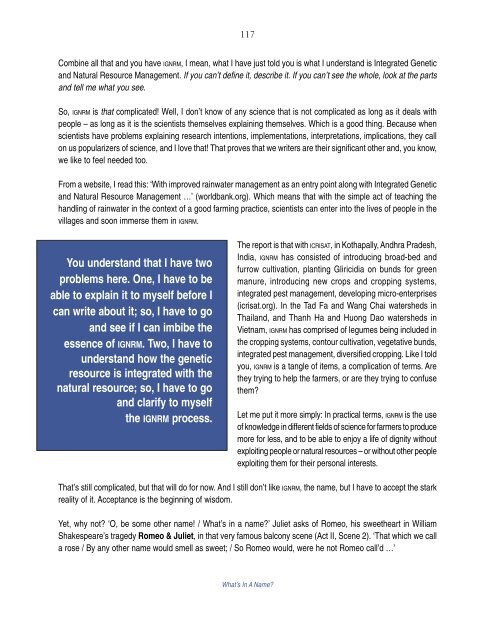Download - icrisat
Download - icrisat
Download - icrisat
You also want an ePaper? Increase the reach of your titles
YUMPU automatically turns print PDFs into web optimized ePapers that Google loves.
117<br />
Combine all that and you have IGNRM, I mean, what I have just told you is what I understand is Integrated Genetic<br />
and Natural Resource Management. If you can’t define it, describe it. If you can’t see the whole, look at the parts<br />
and tell me what you see.<br />
So, IGNRM is that complicated! Well, I don’t know of any science that is not complicated as long as it deals with<br />
people – as long as it is the scientists themselves explaining themselves. Which is a good thing. Because when<br />
scientists have problems explaining research intentions, implementations, interpretations, implications, they call<br />
on us popularizers of science, and I love that! That proves that we writers are their significant other and, you know,<br />
we like to feel needed too.<br />
From a website, I read this: ‘With improved rainwater management as an entry point along with Integrated Genetic<br />
and Natural Resource Management …’ (worldbank.org). Which means that with the simple act of teaching the<br />
handling of rainwater in the context of a good farming practice, scientists can enter into the lives of people in the<br />
villages and soon immerse them in IGNRM.<br />
You understand that I have two<br />
problems here. One, I have to be<br />
able to explain it to myself before I<br />
can write about it; so, I have to go<br />
and see if I can imbibe the<br />
essence of IGNRM. Two, I have to<br />
understand how the genetic<br />
resource is integrated with the<br />
natural resource; so, I have to go<br />
and clarify to myself<br />
the IGNRM process.<br />
The report is that with ICRISAT, in Kothapally, Andhra Pradesh,<br />
India, IGNRM has consisted of introducing broad-bed and<br />
furrow cultivation, planting Gliricidia on bunds for green<br />
manure, introducing new crops and cropping systems,<br />
integrated pest management, developing micro-enterprises<br />
(<strong>icrisat</strong>.org). In the Tad Fa and Wang Chai watersheds in<br />
Thailand, and Thanh Ha and Huong Dao watersheds in<br />
Vietnam, IGNRM has comprised of legumes being included in<br />
the cropping systems, contour cultivation, vegetative bunds,<br />
integrated pest management, diversified cropping. Like I told<br />
you, IGNRM is a tangle of items, a complication of terms. Are<br />
they trying to help the farmers, or are they trying to confuse<br />
them?<br />
Let me put it more simply: In practical terms, IGNRM is the use<br />
of knowledge in different fields of science for farmers to produce<br />
more for less, and to be able to enjoy a life of dignity without<br />
exploiting people or natural resources – or without other people<br />
exploiting them for their personal interests.<br />
That’s still complicated, but that will do for now. And I still don’t like IGNRM, the name, but I have to accept the stark<br />
reality of it. Acceptance is the beginning of wisdom.<br />
Yet, why not? ‘O, be some other name! / What’s in a name?’ Juliet asks of Romeo, his sweetheart in William<br />
Shakespeare’s tragedy Romeo & Juliet, in that very famous balcony scene (Act II, Scene 2). ‘That which we call<br />
a rose / By any other name would smell as sweet; / So Romeo would, were he not Romeo call’d …’<br />
What’s In A Name?

















